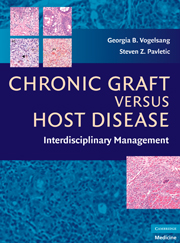Book contents
- Frontmatter
- Contents
- List of Contributors
- Preface
- PART I GENERAL PRINCIPLES
- 1 Historical Aspects of Chronic Graft versus Host Disease
- 2 The Pathophysiology of Acute Graft versus Host Disease
- 3 Pathophysiology of Chronic Graft versus Host Disease
- 4 Animal Models of Chronic Graft versus Host Disease
- 5 Incidence and Trends
- 6 Clinical Manifestations and Natural History
- 7 Risk Factors and Predictive Models for Chronic Graft versus Host Disease
- 8 Biomarkers in Chronic Graft versus Host Disease
- PART II CLINICAL MANAGEMENT
- PART III ORGAN SITE OR SYSTEM-SPECIFIC MANIFESTATIONS
- PART IV SPECIAL CONSIDERATIONS IN CHRONIC GVHD
- Index
- Plate section
7 - Risk Factors and Predictive Models for Chronic Graft versus Host Disease
from PART I - GENERAL PRINCIPLES
Published online by Cambridge University Press: 26 August 2009
- Frontmatter
- Contents
- List of Contributors
- Preface
- PART I GENERAL PRINCIPLES
- 1 Historical Aspects of Chronic Graft versus Host Disease
- 2 The Pathophysiology of Acute Graft versus Host Disease
- 3 Pathophysiology of Chronic Graft versus Host Disease
- 4 Animal Models of Chronic Graft versus Host Disease
- 5 Incidence and Trends
- 6 Clinical Manifestations and Natural History
- 7 Risk Factors and Predictive Models for Chronic Graft versus Host Disease
- 8 Biomarkers in Chronic Graft versus Host Disease
- PART II CLINICAL MANAGEMENT
- PART III ORGAN SITE OR SYSTEM-SPECIFIC MANIFESTATIONS
- PART IV SPECIAL CONSIDERATIONS IN CHRONIC GVHD
- Index
- Plate section
Summary
INTRODUCTION
Although there has been significant change in allogeneic hematopoietic cell transplantation (HCT) practice over the last four decades, chronic graft versus host disease (chronic GVHD) remains a major barrier to the ultimate success of HCT. The ability to predict who will develop chronic GVHD, how severe the organ manifestation will become, and whether the decreased relapse risk associated with chronic GVHD is offset by the increased morbidity and treatment-related mortality from chronic GVHD is of great clinical importance. Better understanding of these predictors would also aid in chronic GVHD research since appropriate patients could be targeted for prevention and treatment trials. Single arm studies would be easier to interpret if we had greater confidence in estimating the course of chronic GVHD treated with “standard care.”
This chapter is intended to provide updated information for clinicians to recognize important risk factors for the occurrence and prognosis of chronic GVHD. Recently developed predictive models for prognosis of chronic GVHD are also described.
RISK FACTORS FOR THE DEVELOPMENT OF CHRONIC GVHD
Incidence
The overall chance of developing chronic GVHD is approximately 60% after allogeneic HCT, although published estimates range from 30% to 85%. In a review of 116 human leukocyte antigen (HLA)-identical peripheral blood HCT recipients, limited chronic GVHD occurred in 6%, and clinical extensive chronic GVHD in 71%. Data from the National Marrow Donor Program (NMDP) indicate that up to 70% of patients receiving adult unrelated donor marrow grafts who survive beyond day 100 develop chronic GVHD.
- Type
- Chapter
- Information
- Chronic Graft Versus Host DiseaseInterdisciplinary Management, pp. 70 - 78Publisher: Cambridge University PressPrint publication year: 2009



